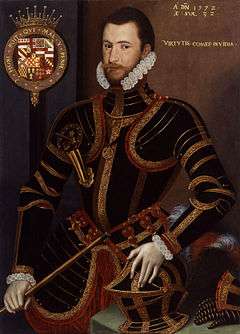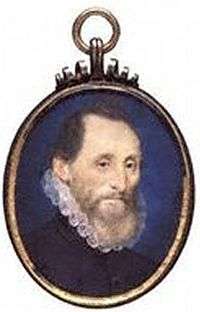George Carleton (MP)
George Carleton (1529 – January 1590) was a lawyer, landowner and Member of Parliament with strong Puritan sympathies. It has been suggested that he was the secret author of the Marprelate tracts, and both he and his third wife were prosecuted for their involvement in the Marprelate controversy. Ordered to appear daily before the Privy Council in April 1589, he died in early 1590 before a decision in the proceedings against him had been reached.[1][2]
George Carleton | |
|---|---|
| Born | 1529 |
| Died | January 1590 (aged 60–61) |
| Spouse(s) |
|
Issue
| |
| Father | John Carleton |
| Mother | Joyce Welbeck |
Family
George Carleton, born in 1529, was the second son of John Carleton of Walton-on-Thames, Surrey, and Brightwell Baldwin, Oxfordshire, and Joyce Welbeck, the daughter of John Welbeck of Oxon Hoath, Kent. His maternal grandmother, Margaret Culpepper, was the aunt of Henry VIII's fifth wife, Katherine Howard.[1][3]
The inscription on his father's monument states that he had four brothers, Anthony Carleton (grandfather of Dudley Carleton, 1st Viscount Dorchester);[4] William (said to have been a priest); John (who died unmarried at Bologna); and Edward, and four sisters: Anne, who married Rowland Lytton;[5] Katherine, who married Francis Blount, younger brother of James Blount, 6th Baron Mountjoy;[4] Mabel, who married John Fetch of Haddenham, Buckinghamshire; and Jane, who married Erasmus Gainsford, son of Sir John Gainsford (d.1540) of Crowhurst, Surrey.[6]
Career


Carleton's father had been receiver to the Abbot of Westminster and deputy receiver-general to the Dean and Chapter of Westminster, and through this connection George Carleton was granted an exhibition at Christ Church, Oxford.[1][3] In 1552 he was admitted to Gray's Inn.[1] He later used his legal skills in the interests of friends, kinsmen and others, acting as trustee in the affairs of his brother, Anthony Carleton, his brother-in-law, Rowland Lytton, Sir Richard Knightley,[7][8] and James Blount, 6th Baron Mountjoy, who by 1566 was thousands of pounds in debt.[3]
He served in a military capacity on two occasions, in 1557 as a captain at the siege of St Quentin, and in 1573 as treasurer to the Earl of Essex's expedition to Ireland.[1][3]
Over time he became a substantial landowner. He inherited his father's property at Walton-on-Thames, and spent his early years there, but by 1568 had conveyed it to his younger brother, Edward.[3] His inheritance from his father also included lands in Cambridgeshire and Huntingdonshire. Through his second marriage he acquired lands in Oxfordshire and Northamptonshire, including the manor of Overstone, which he used as a principal residence.[1][3] He also purchased extensive lands in Gloucestershire,[3] and during the later part of his life acquired substantial interests in former monastic properties in the fenlands, including some 1000 acres of marshland used for grazing, as well as a house in Wisbech and the manor of Coldham.[3][9] As a landowner in the Lincolnshire fens he pioneered the use of windmills, served as a commissioner for sewers,[10] and was the first to have 'inned any marsh in Holland'.[1]
He was also involved in financial transactions with his stepson by his second marriage, Sir Anthony Cope. In 1571 they entered into a recognizance in the amount of £1000, and in 1576 Carleton was granted the stewardship of the manor of Wollaston in Northamptonshire, which he appears to have obtained for Cope's benefit.[3]
He served as a Justice of the Peace in the counties of Oxfordshire, Northamptonshire, and Lincolnshire, as well as the Isle of Ely. Perhaps through the influence of Francis Russell, 2nd Earl of Bedford, he was chosen as a Member of Parliament for Poole in 1571 and Dorchester in 1572, 1576, and 1581.[1] He was also superintendent over the Jesuits and Catholic recusants during their imprisonment in Wisbech Castle.[1]
Carleton was an 'ardent' Puritan who believed that Elizabeth I's only 'reliable subjects' were Puritans like himself, and put forward to Lord Burghley a proposal that the Queen's Catholic subjects should be settled on plantations in Ireland, as well as a proposal for a militia composed 'chiefly of such as be religious' to guard the Queen.[3][1] He befriended Percival Wiburn, a Puritan preacher in Northampton, and after Wiburn had been silenced by the authorities, brought two other radical ministers from London, Nicholas Standon and Edward Bulkeley, whose sermons were given at Carleton's home at Overstone.[3] In Parliament, he devoted his energies to bringing about further religious reform 'along Presbyterian lines', supporting the efforts in that regard of William Strickland, Paul Wentworth, and Peter Wentworth.[1]
Carleton's Puritan views led him, during the last year of his life, to involvement in the printing of the Marprelate tracts. In 1589 he married 'Mistress Crane', at whose country home at East Molesey in Surrey, across the river from Hampton Court Palace, the first of the Marprelate tracts, Martin's Epistle, was printed by Robert Waldegrave on a secret press in October 1588.[11][2][12][13]
After the printing of the Epistle, the press was moved to Fawsley in Northamptonshire, the home of Sir Richard Knightley, whom Collinson terms 'an enthusiast not entirely compos mentis, whose affairs were in Carleton's hands'.[1] Martin's Epitome was printed at Fawsley. From there the press was taken to the Whitefriars in Coventry, and to Wolston Priory in Warwickshire, where further tracts were printed. Although the secret press was not captured by agents of Henry Stanley, 4th Earl of Derby, until August 1589, according to Carlson, as early as April 1589 Carleton had been ordered to appear before the Privy Council, and directed to attend daily until given permission to depart.[14] After the capture of the secret press in August, those in whose homes the Marprelate tracts had been printed were arrested and imprisoned in the Fleet. Carleton died in early January 1590 before a decision had been reached in any proceedings which may have been instigated against him. His widow was ordered by the Court of Star Chamber to be imprisoned at the Queen's pleasure, and heavily fined, as were others who had been involved.[1][2][15][16]
Both Longley and Collinson have suggested that Carleton might have been the secret author of the Marprelate tracts.[1][17][18]
Marriages and issue
He married firstly, in 1559, Audrey Gainsford, widow successively of George Taylor of Lingfield, Surrey, and Sir George Harper (1503–1558) of Sutton Valence, Kent, and daughter of Sir John Gainsford (d.1540) of Crowhurst, Surrey, and his fifth wife Audrey Shaa, daughter of Sir John Shaa, Lord Mayor of London. She died in early 1560.[19][20][6][1][21]
He married secondly, in 1561, Elizabeth Mohun (d.1587), widow of Edward Cope of Hanwell, Oxfordshire and daughter of Walter Mohun of Overstone,[1] by whom he had a son, Castle Carleton, and a daughter, Elizabeth Carleton.[22]
He married thirdly Elizabeth Hussey, the eldest daughter of Sir Robert Hussey (d.1546) of Linwood, Lincolnshire, and his second wife, Jane Stydolf, the daughter of Thomas Stydolf of Surrey.[23][2] Her father was a younger brother of John Hussey, 1st Baron Hussey of Sleaford,[24][25] while her paternal grandparents were William Hussey (d.1495), Chief Justice of the King's Bench, and Elizabeth Berkeley, the daughter of Thomas Berkeley of Wymondham, Leicestershire.[26][27]
There were no children of his first and third marriages.[6]
Notes
- Collinson 2004.
- Cross 2004.
- Carleton, George (1529–90), of Overstone, Northamptonshire, Wisbech and Coldham, Isle of Ely, History of Parliament Retrieved 10 December 2013.
- Fuidge, N.M., 'Carleton, Anthony (c.1522–76), of Brightwell Baldwin, Oxfordshire, History of Parliament Retrieved 15 December 2013.
- Lytton, Sir Rowland (1561–1615), of Knebworth, Hertfordshire, History of Parliament Retrieved 15 December 2013.
- Turner 1871, p. 123.
- Jointly with Christopher Yelverton.
- Knightley, Sir Richard (1533–1615), of Fawsley, Northamptonshire, History of Parliament Retrieved 15 December 2013.
- 'Wisbech Hundred: Elm', A History of the County of Cambridge and the Isle of Ely: Volume 4: City of Ely; Ely, N. and S. Witchford and Wisbech Hundreds (2002), pp. 180–186.
- Kennedy, Mark E. (1983). "Fen Drainage, the Central Government, and Local Interest: Carleton and the Gentlemen of South Holland*". The Historical Journal. 26: 15. doi:10.1017/S0018246X00019580.
- Black 2008, pp. l–li.
- Pierce 1908, p. 155.
- Carlson 1981, pp. 22, 31.
- Carlson 1981, p. 24.
- Carlson 1981, pp. 22, 24–5, 31, 41, 366.
- Pierce 1908, pp. 158–60, 177–9.
- Carlson 1981, pp. 24–5.
- Collinson 2013, p. 64.
- French 1865, p. 60.
- Howard 1874, pp. 326–7.
- Harper, George (1503–58), of Sutton Valence, Kent and London, History of Parliament Retrieved 14 December 2013.
- Metcalfe 1887, p. 9.
- Maddison 1903, p. 528.
- McCorkle 1931, pp. 276–83.
- Burke 1866, p. 294.
- Doe 2004.
- Hussey, William I (by 1473–?1531), of London; Sleaford, Lincolnshire; North Duffield, Yorkshire, and Calais, History of Parliament Retrieved 14 December 2013.
References
- Black, Joseph L., ed. (2008). The Martin Marprelate Tracts; A Modernized and Annotated Edition. Cambridge: Cambridge University Press. pp. l–li.CS1 maint: ref=harv (link)
- Burke, Bernard (1866). A Genealogical History of the Dormant, Abeyant, Forfeited and Extinct Peerages of the British Empire. London: Harrison.CS1 maint: ref=harv (link)
- Carlson, Leland H. (1981). Martin Marprelate, Gentleman: Master Job Throckmorton Laid Open in His Colors. San Marino, California: The Henry E. Huntington Library.CS1 maint: ref=harv (link)
- Collinson, Patrick (2004). "Carleton, George (1529–1590)". Oxford Dictionary of National Biography (online ed.). Oxford University Press. doi:10.1093/ref:odnb/37261. (Subscription or UK public library membership required.)
- Collinson, Patrick (2013). Richard Bancroft and Elizabethan Anti-Puritanism. Cambridge: Cambridge University Press.CS1 maint: ref=harv (link)
- Cross, Claire (2004). "Crane, Elizabeth (d. in or before 1606)". Oxford Dictionary of National Biography (online ed.). Oxford University Press. doi:10.1093/ref:odnb/68274. (Subscription or UK public library membership required.)
- Doe, Norman (2004). "Hussey, Sir William (d. 1495)". Oxford Dictionary of National Biography (online ed.). Oxford University Press. doi:10.1093/ref:odnb/14271. (Subscription or UK public library membership required.)
- French, G.R. (1865). "A Brief Account of Crowhurst Church, Surrey, and Its Monuments". Surrey Archaeological Collections. London: Lowell Reeve & Co. III: 39–62.CS1 maint: ref=harv (link)
- Howard, Joseph Jackson, ed. (1874). "The Visitation of Surrey". Surrey Archaeological Collections. London: Wyman & Sons. VI: 326–7. Retrieved 15 December 2013.CS1 maint: ref=harv (link)
- McCorkle, Julia Norton (1931). "A Note concerning 'Mistress Crane' and the Martin Marprelate Controversy". The Library. 4th. XII (3): 276–83. doi:10.1093/library/s4-XII.3.276. Retrieved 10 December 2013.CS1 maint: ref=harv (link)
- Maddison, A.R., ed. (1903). Lincolnshire Pedigrees, Vol. II. LI. London: Harleian Society. pp. 526–32. Retrieved 14 December 2013.CS1 maint: ref=harv (link)
- Metcalfe, Walter C. (1887). The Visitations of Northamptonshire. London: Harleian Society. Retrieved 10 December 2013.CS1 maint: ref=harv (link)
- Pierce, William (1908). A Historical Introduction to the Marprelate Tracts. New York: Burt Franklin. Retrieved 10 December 2013.CS1 maint: ref=harv (link)
- Turner, William Henry, ed. (1871). The Visitations of the County of Oxford. V. London: Harleian Society. p. 123. Retrieved 27 December 2013.CS1 maint: ref=harv (link)
External links
- Will of George Carleton of Overstone, Northamptonshire, proved 16 January 1590, PROB 11/75/14, National Archives Retrieved 15 December 2013
- Will of Anthony Carleton of Brightwell, Oxfordshire, proved 2 June 1576, PROB 11/58/192, National Archives Retrieved 16 December 2013
- Will of George Taylor of Lingfield, Surrey, proved 28 January 1544, PROB 11/30/20, National Archives Retrieved 15 December 2013
- Will of Sir John Gainsford, proved 29 October 1540, PROB 11/28/264, National Archives Retrieved 15 December 2013